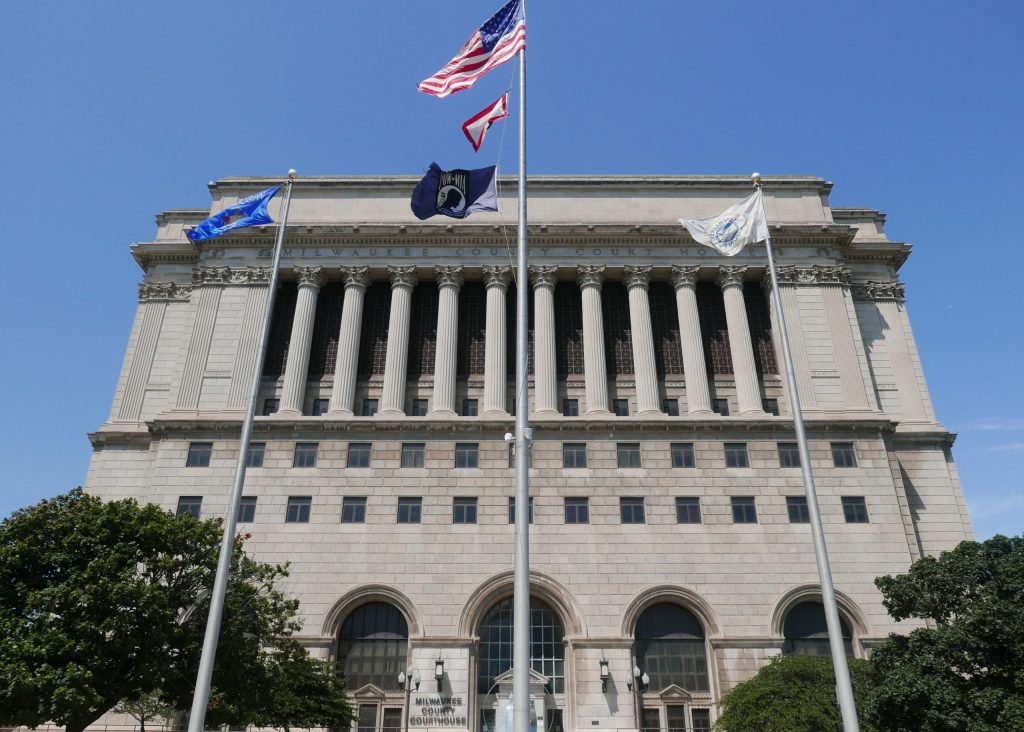Supervisors Push Sustainable Building Designs
Proposed standards would help county hit net-zero carbon emissions by 2050

Milwaukee County Courthouse. Photo by Graham Kilmer.
The Milwaukee County Board is moving to approve new sustainable design standards for county buildings.
The new standards follow legislation passed in April that laid out the county’s strategic plan for achieving net-zero carbon emissions by 2050. The new sustainable design standards were one of the strategies included in the plan.
“Now that these are fully developed and ready to be implemented, we see it as just another step in the direction of helping us work towards achieving that carbon neutral goal,” Grant Helle, county sustainability director, told supervisors on the Committee on Economic Development and Environment Monday.
The design standards resolution was sponsored by Sup. Anne O’Connor, and has picked up support from nine of her 17 colleagues on the board, suggesting it will eventually be passed. The resolution was drafted to single out the design standards and begin pushing the county toward using the tools in its 2050 plan, O’Connor said, especially as it is in the midst of designing a new criminal courthouse, which will be the biggest public works project in county history.
“So this is something that will help evaluate re-construction and new construction projects in the county,” O’Connor said.
Sup. Caroline Gómez-Tom, a co-sponsor, characterized the standards as a “deliverable” for county officials to begin implementing the strategic plan.
The new design standards can be incorporated during the initial phases of building projects, and provide department heads with a toolkit for determining what carbon reduction or efficiency strategies to pursue, Helle said. They can also be shared with local municipalities interested in a tool to help them reduce their carbon footprint.
Sup. Steve Taylor, chair of the committee, said the new resolution, “doesn’t have any teeth.” He pointed to the language in the resolution, suggesting that the administration could ignore design standards in the future if it wanted to. He also said he may introduce an amendment requiring projects to include an upfront cost estimate for any costs that contribute to the county’s carbon neutrality goal.
“I think we do definitely need to know what the upfront cost is and and then what the savings are as well,” Taylor said, explaining that he thinks future supervisors should know the cost of these goals, which he sees in competition with funding for a “park project, a playground, a road, a bridge.”
It’s estimated the county’s emission reduction plan will cost approximately $441 million over the next 25 years, on top of existing projected costs.
“There could be an increased upfront cost for these projects,” Helle said. “However, with these standards… we do expect that this will generate long term savings through reduced operations and… energy costs.”
Calculating the savings is trickier than calculating the upfront costs, and, in the case of building design standards, will likely require some level of energy modeling for each building, Helle said.
Sup. Steven Shea said he would support an amendment requiring an estimate on all future projects of both initial added costs and long-term savings.
“When we make a building energy efficient, it is not just ecological do-gooder-ism, we are saving money in the long run,” he said. “Now, obviously there’s an upfront cost for that, but in the long run, hopefully we’ll actually save money for the taxpayer.”
Legislation Link - Urban Milwaukee members see direct links to legislation mentioned in this article. Join today
If you think stories like this are important, become a member of Urban Milwaukee and help support real, independent journalism. Plus you get some cool added benefits.
MKE County
-
Wehr Nature Center Fund Drive Will Pay for Changes
 May 10th, 2025 by Graham Kilmer
May 10th, 2025 by Graham Kilmer
-
County Replaces Its Oldest Playground
 May 9th, 2025 by Graham Kilmer
May 9th, 2025 by Graham Kilmer
-
County Wants To Boost Small Business, Commercial Corridors
 May 8th, 2025 by Graham Kilmer
May 8th, 2025 by Graham Kilmer




















